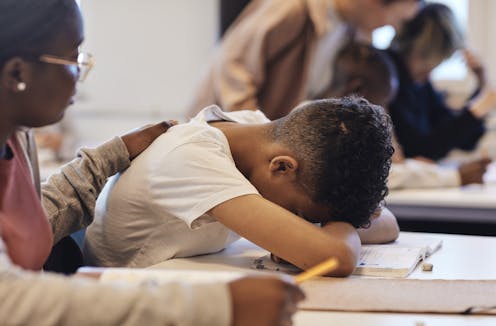Why holding kids back fails − and what to do about it
- Written by Laura Link, Associate Professor of Teaching and Leadership, University of North Dakota
 Children struggle with shame and alienation when they are forced to repeat a grade in school.Maskot via Getty Images
Children struggle with shame and alienation when they are forced to repeat a grade in school.Maskot via Getty ImagesFor decades, schools have allowed children to advance to the next grade even when they’re not reading at grade level. But more and more states are adopting policies to hold students back if they fail standardized tests in reading.
As of now, 26 states have such policies, compared with just 18 states five years ago. This month, Maryland lawmakers will consider their own policy to hold back third graders who struggle with reading, while allowing parents to opt out as long as they agree to get their child extra reading support.
The looming decision in Maryland, where 69% of students are not reading at grade level, has reignited a century-long debate about the consequences of “flunking” students. Based on what the research shows, we believe parents and guardians would be wise to explore their options to opt out of the retention policy. We say this because of what we know to be the negative effects associated with forcing a child to repeat a grade.
While giving struggling learners another year to master essential skills may seemingly make sense, evidence suggests that holding kids back often does more harm than good. Not only do these students have a higher risk of dropping out before graduating high school, but the practice also reinforces historical inequities in education.
As researchers who study grading and education policy, we offer five reasons why we don’t see holding students back as an effective educational strategy.
1. Hinders academic progress
Students held back in the early elementary grades show lower academic achievement in year-end reading scores compared with their promoted peers both during and after the retention year, according to a multiyear study published in 2018. This lag in students’ performance persists through their middle school years.
Even more concerning, any short-term academic gains from retention often disappear after the student is promoted the following year, another comprehensive study found. This is partly because students encounter the same teaching and grading methods that didn’t work for them the first time around.
2. Limits social and emotional development
Students held back in elementary school experience increased feelings of shame and alienation, research shows. These feelings linger into adolescence. These students also grapple with lower self-esteem and more anxiety compared with their promoted peers, which could limit their overall social and emotional development.
3. Increases dropout risk
Students held back in elementary grades were 60% less likely to graduate high school by age 20 compared with their similarly achieving peers who were not held back, one study found. A 2018 study corroborated these findings, even after controlling for prior achievement and socioeconomic status.
4. Costs more for school districts
The estimated cost of retention is US$13,000 to $35,000 per student a year, depending on the school district. The total cost to U.S. taxpayers is over $18 billion every year. The costs continue to add up over a lifetime, too, since holding students back is associated with increased dropout rates and reduced lifetime earnings.
5. Disadvantages poor and minority students
As do other policies in education, holding students back affects poor and minority students significantly more than their higher-income and white peers, research has found.
Retention policies are also often associated with greater rates of suspension and less access to advanced classes.
Decisions about whether a student should be held back often rely on measures such as standardized test scores. But research shows there’s a long history of racial bias in these tests, which tend to favor white, Asian and higher-income students.
Reliance on high-stakes tests reinforces bias in education and creates a system that simultaneously hamstrings teachers and blames them for test results that are beyond their control.
Another path forward
 Struggling students may benefit from personalized lessons.Lorado/E+ via Getty Images
Struggling students may benefit from personalized lessons.Lorado/E+ via Getty ImagesIt’s not fair to penalize students when educators and policymakers have the power to address student reading issues before and throughout third grade. Instead, we believe less weight should be placed on high stakes tests, and teachers should be trusted and taught to implement more effective ways to help students who are behind in reading.
Here are a few ways that teachers can better support students in reading:
Identify learning gaps regularly: Kindergarten through third grade teachers should regularly evaluate their students’ academic performance and adjust their teaching methods based on what they conclude. Recent research demonstrates that this approach can lead to significant improvements in reading outcomes.
Use standards to guide learning: By focusing on students’ individual growth – rather than comparing them with their peers – teachers and parents can better understand how well a student is doing in reading. When students need help, teachers can provide more targeted interventions.
Separate behavior and academic performance: Teachers should separate students’ behavior, including effort and participation, from their academic performance in the grade book. This gives a more accurate picture of students’ actual reading skills and areas where they can improve.
Enhance teacher training: The above recommendations work only if teachers understand how to interpret and regularly use their students’ classroom assessment data. This is what allows them to personalize lessons for struggling students. Many teacher preparation programs in the U.S. fall short in this area. Some innovative universities, however, are preparing educators to design and implement effective classroom assessment and grading practices that are fair, accurate and meaningful for all students.
These classroom-based, teacher-driven practices can not only benefit individual students, but they can also reduce the financial and emotional costs associated with grade retention.
The path forward lies not in holding students back but in pushing these educational practices forward. Education leaders can ensure that every student receives proactive support – instead of experiencing the shame and setbacks associated with having to repeat a year in school.
Dr. D'Amico Pawlewicz's research has been supported by the Spencer Foundation.
Laura Link does not work for, consult, own shares in or receive funding from any company or organization that would benefit from this article, and has disclosed no relevant affiliations beyond their academic appointment.
Authors: Laura Link, Associate Professor of Teaching and Leadership, University of North Dakota
Read more https://theconversation.com/why-holding-kids-back-fails-and-what-to-do-about-it-236380

